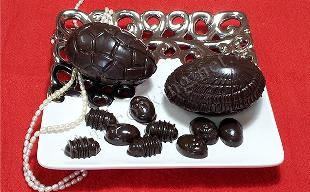Whats Cooking
inspiring to cook n bakeCategories
- Basics
- Beauty
- Beef, Mutton And Pork
- Beverages, Smoothies And Juices
- Break Fast Dishes
- Cakes, Cookies And Bakes
- Chocolate, Ice Creams And Frozen Treats
- Cocktails, Mocktails And Wines
- Continental And Indian Breads
- Desserts
- Dips, Chutneys And Sauces
- Household
- Masalas
- Paneer
- Pickles, Preserves And Jams
- Poultry And Egg
- Rice, Noodles And Pasta
- Salads And Sandwiches
- Seafood
- Snacks, Sweets And Savories
- Soups, Starters And Accompaniments
- Vegetarian
Feedback
DISH NAME : CHOCOLATE EASTER EGGS
Description
Easter eggs are given or made during Easter. Traditionally dyed or painted chicken eggs were used, but now that has been substituted with chocolate eggs, or eggs made with royal icing ,filled with confectionery. These eggs can be hidden for children to find on Easter morning, who are told they were left by the Easter Bunny / Easter Rabbit- just as Santa Claus does during christmas. The egg is used as a symbol of the start of new life (resurrection ) - just as new life emerges from an egg when the chick hatches out.
Note
1)When melting chocolate take care not to burn. For this dont wait till the last piece of chocolate is melted to remove from double boiler. Even if there are small unmelted pieces, keep on stirring to ensure the whole thing melts evenly. Chocolate can also be melted in a microwave. Use 30 second bursts. Take out and stir and repeat twice or thrice.
2) Its much safer to do it on a bain marie or double boiler .
3)Fill the eggs, before joining them together, with gems or dryfruits .
4) I used dark chocolatecompound by Morde for the eggs, but in case you dont get it, substitute with any normal plain dark chocolate. Use a good brand. Do not use compound & chocolate together.
5) When sticking eggs together, & if your hands are very warm, use gloves or it will melt the eggs.
| Quantity | Name |
|---|---|
| 300 Gm.s | Chocolate, dark compound |
| 6 No.s | Small egg moulds |
Method
1) Polish the inside of each egg mould with a piece of cloth. Then wet a piece of cloth with a little flavourless oil and polish the inside of each mould with the oil. This ensures a highly polished finish to the chocolate and also helps to release the set chocolate from the mould.
2) If using pure chocolate, instead of compound, It is essential to temper the chocolate. This is a method of heating and cooling chocolate for coating or moulding. The heating and cooling separates the cocoa solids and ensures the set chocolate will have a high gloss and smooth finish. To temper the chocolate you will need a cooking thermometer, a heat-proof bowl and saucepan of hot water. Break the chocolate into small, even pieces and melt gently in a bowl over a saucepan of hot, not boiling, water. Place the thermometer into the chocolate and heat until it reaches 43C/110F. Take off the heat and cool to 35C/95F. Now it is ready to use.
3) Melt compound either on a double boiler or in a microwave in 30 second bursts.
4) Pour spoonfuls of the chocolate into each mould. Swirl around until coated, and then remove excess chocolate. Leave to set, flat side down, on a surface.
5) Fill each mould in the same way. You will have to repeat the process another two or three times to build up a good layer of chocolate in each mould.
6) Wait for about 20 minutes for the chocolate to set in between layers. Draw the flat edge of a knife across the mould to ensure a clean edge every time you add a layer. This is important so that the two sides of the egg stick together evenly. Leave to chill in fridge until set. Carefully un-mould the egg halves and place on a clean surface taking care not to handle the chocolate too much as it will start to melt from the heat of your hands. To stick the two edges of an egg together, heat a baking sheet and then place the edges of two halves on it for a few seconds, then gently stick the edges together. Keep refrigerated till use.
7) Keep in the fridge.
